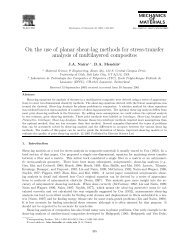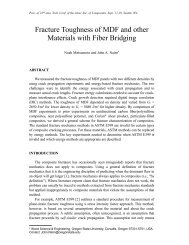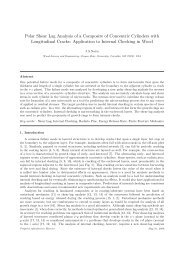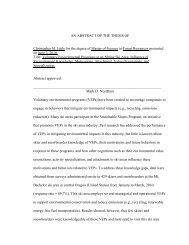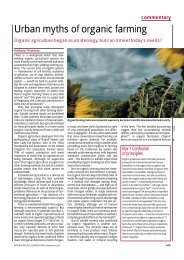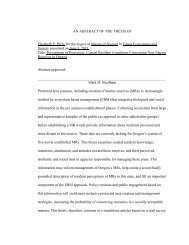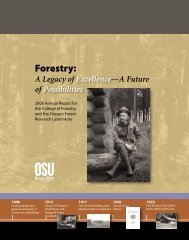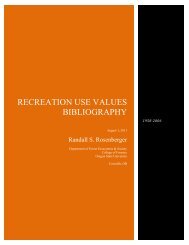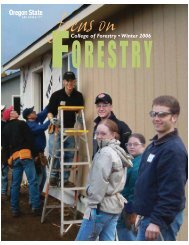Fall 2012 - College of Forestry - Oregon State University
Fall 2012 - College of Forestry - Oregon State University
Fall 2012 - College of Forestry - Oregon State University
Create successful ePaper yourself
Turn your PDF publications into a flip-book with our unique Google optimized e-Paper software.
FOCUS<br />
THE MAGAZINE OF OSU COLLEGE OF FORESTRY<br />
<strong>Fall</strong> <strong>2012</strong>
Dean’s Column<br />
Greetings. It is a real honor to be writing the Dean’s Column.<br />
Two years ago I was wondering about the challenges and<br />
opportunities <strong>of</strong> coming to <strong>Oregon</strong> <strong>State</strong> <strong>University</strong> as a<br />
department head, and now I’ve just quadrupled those thoughts<br />
for myself. Actually, I’m really excited to be in this position!<br />
Since arriving I’ve learned that the <strong>College</strong> has a very talented<br />
faculty and staff who are dedicated to the success <strong>of</strong> our students<br />
and programs. I want to thank them for their confidence in me<br />
to provide leadership for this continuing quest. I’ve had the<br />
opportunity to meet many others around campus. I look forward<br />
to continuing and new collaborations between units as we all<br />
work to make OSU a world-class land-grant university.<br />
I’ve also had the opportunity to meet many leaders around the Northwest who value our<br />
forests and natural ecosystems for a multiplicity <strong>of</strong> economic, social, and environmental<br />
needs. I look forward to expanding this list <strong>of</strong> stakeholders and deepening our relationships and<br />
mutual respect for the sustainable management <strong>of</strong> our natural resources to meet the needs <strong>of</strong><br />
an ever-expanding population.<br />
Finally, I must thank Hal. He has faced new challenges while serving as Dean, and has<br />
helped the <strong>College</strong> to adapt to change. He has left me a strong foundation and starting<br />
point for implementing new ideas on broadening the reach <strong>of</strong> our research, expanding our<br />
programmatic collaboration with others, and producing the most sought-after, pr<strong>of</strong>essional<br />
students in the world.<br />
I have seven overarching goals that I will always bear in mind. Space is limited, but the basic<br />
ideas are: (1) We will provide top-tier pr<strong>of</strong>essional forestry education. With many schools<br />
abandoning science-based land management, OSU will be the destination <strong>of</strong> choice for<br />
students and employers. (2) Diversify. Our graduates will work in diverse communities and<br />
cultures around the world, so we need to set the benchmark for inclusion <strong>of</strong> faculty, staff, and<br />
students. (3) Double enrollment. We need a critical mass for our degree programs to remain<br />
sustainable. (4) Broaden our funding base. Relying on state appropriations and student tuition<br />
provides too much flux for program planning. (5) Strengthen the FRL. Our scientific efforts will<br />
be channeled into four broad reaching institutes. One <strong>of</strong> them is described in this issue. (6)<br />
Internationalize, with a focus on the Pacific Rim. (7) Strengthen the public/private partnership.<br />
Our R&D must enhance the competitiveness <strong>of</strong> the Northwest forest sector.<br />
This is an ambitious plan. I hope it is a vision we can share and work toward.<br />
Congratulations to the <strong>2012</strong> <strong>College</strong> <strong>of</strong> <strong>Forestry</strong><br />
initiates into the honor society Phi Kappa Phi, the<br />
land-grant university equivalent <strong>of</strong> Phi Beta Kappa:<br />
Juniors — Todd Bertwell and Shane Prohaska<br />
Seniors — Dorian Alexanderson, Alexandra<br />
Pederson, Glynnys D. Pentecoste, Lori Leigh<br />
Price, and Danielle Lynn Womble<br />
Alumnus — Benjamin LeBlanc<br />
Faculty — Michael Wing<br />
<strong>2012</strong> Phi Kappa Phi Initiation and Awards<br />
At the ceremony, Matt Betts received a Phi Kappa<br />
Phi Emerging Scholar Award in recognition <strong>of</strong> his<br />
outstanding research efforts.<br />
Additional representatives from the <strong>College</strong> <strong>of</strong><br />
<strong>Forestry</strong> who attended the initiation and awards<br />
ceremony included PKP Student Vice President<br />
Claire Rogan, outgoing PKP President Temesgen<br />
Hailemariam, PKP Treasurer Kevin Boston, John<br />
Sessions, Thomas Maness, and Jessica Fontaine.
Dean<br />
Thomas Maness<br />
Development Director<br />
Zak Hansen<br />
Managing Editor<br />
Caryn M. Davis<br />
Writers<br />
Bryan Bernart<br />
Caryn M. Davis<br />
Designer<br />
Sandra Arbogast<br />
Photographers<br />
Logan Bernart, Becky Brenton,<br />
Forrest Briggs, Stephen<br />
Fitzgerald, Adam Hadley,<br />
Scott Leavengood,<br />
Jeffrey Wimer, <strong>Forestry</strong><br />
Communications, and others<br />
How to Reach Us<br />
Address changes:<br />
Tonya Fodge<br />
<strong>Oregon</strong> <strong>State</strong> <strong>University</strong><br />
Foundation<br />
850 SW 35th Street<br />
Corvallis, OR 97333<br />
Tonya.Fodge@oregonstate.edu<br />
(541) 737-9846<br />
Other questions/comments:<br />
Caryn Davis<br />
<strong>College</strong> <strong>of</strong> <strong>Forestry</strong><br />
<strong>Oregon</strong> <strong>State</strong> <strong>University</strong><br />
154 Peavy Hall<br />
Corvallis, OR 97331-5704<br />
caryn.davis@oregonstate.edu<br />
www.forestry.oregonstate.edu<br />
For information specifically about the<br />
Focus magazine and other publications,<br />
call (541) 737-4270. For questions about<br />
<strong>College</strong> <strong>of</strong> <strong>Forestry</strong> events and other<br />
matters, contact the Dean’s <strong>of</strong>fice at<br />
(541) 737-1585, or visit the website at<br />
www.forestry.oregonstate.edu<br />
Focus is published by <strong>Oregon</strong> <strong>State</strong><br />
<strong>University</strong> <strong>College</strong> <strong>of</strong> <strong>Forestry</strong>. Our goal is<br />
to keep <strong>Forestry</strong> alumni, friends, faculty,<br />
staff, and students informed about the<br />
<strong>College</strong> <strong>of</strong> <strong>Forestry</strong> and its many activities<br />
and programs.<br />
All or parts <strong>of</strong> this publication may be<br />
reproduced with credit to the OSU <strong>College</strong><br />
<strong>of</strong> <strong>Forestry</strong>. <strong>Oregon</strong> <strong>State</strong> <strong>University</strong><br />
is an Affirmative Action and Equal<br />
Opportunity employer and complies with<br />
Section 504 <strong>of</strong> the Rehabilitation Act<br />
<strong>of</strong> 1973. Gift funds provided to the OSU<br />
Foundation and the <strong>College</strong> <strong>of</strong> <strong>Forestry</strong><br />
help pay for color reproduction <strong>of</strong> the<br />
Focus.<br />
Does the <strong>College</strong> <strong>of</strong> <strong>Forestry</strong> have your<br />
e-mail address? Please help the college<br />
save money and improve communication<br />
by sharing your e-mail address. Please<br />
send an e-mail to Tonya.Fodge@<br />
oregonstate.edu and ask us to update our<br />
e-mail records. Thank you.<br />
FOCUS<br />
THE MAGAZINE OF OSU COLLEGE OF FORESTRY<br />
Contents<br />
FALL <strong>2012</strong><br />
Introducing Dean Thomas Maness 2<br />
Seeing the Forest and the Trees: New Working<br />
Forests Institute to highlight connections<br />
between communities and the natural environment 4<br />
Bioacoustics in Birdland: How computer scientists<br />
and wildlife ecologists are changing the way we listen<br />
to the environment 6<br />
Tomorrow’s Research Today: WS&E undergrads<br />
are shaping the face <strong>of</strong> renewable materials science 8<br />
Cold Play: Conclave Comes to Corvallis<br />
73rd Annual AWFC gathering a time for competition<br />
and camaraderie 10<br />
Reflections from Dean Hal Salwasser 13<br />
Cover: Cal Poly Logger<br />
Melissa Pechter<br />
competes in vertical<br />
chop at the 73rd<br />
AWFC Conclave in<br />
Corvallis, March <strong>2012</strong>.<br />
Photo credit: Jeffrey<br />
Wimer, Director <strong>of</strong><br />
the Student Logging<br />
Training Program and<br />
Advisor <strong>of</strong> the OSU<br />
Logging Sports Team.<br />
Attention Job Seekers<br />
and Employers!<br />
The Student Services<br />
Office <strong>of</strong>fers an employment<br />
site where alumni can find<br />
job announcements and<br />
employers can advertise<br />
their open positions.<br />
See what’s available at<br />
jobs.forestry.oregonstate.<br />
edu<br />
Or call 541-737-1594<br />
to advertise your open<br />
position(s).
Introducing Dean<br />
Thomas Maness<br />
By Bryan Bernart<br />
On August 1st, Thomas Maness, pr<strong>of</strong>essor <strong>of</strong> Forest<br />
Economics and Policy and Head <strong>of</strong> the Department<br />
<strong>of</strong> Forest Engineering, Resources and Management,<br />
became the new Cheryl Ramberg and Allyn C. Ford<br />
Dean <strong>of</strong> <strong>Forestry</strong> and Director <strong>of</strong> the <strong>Oregon</strong> Forest<br />
Research Laboratory. This appointment followed<br />
Hal Salwasser’s planned departure from the<br />
position at the conclusion <strong>of</strong> the 2011-<strong>2012</strong> school<br />
year. Maness inherits a <strong>College</strong> that has grown<br />
significantly in size as well as in the breadth <strong>of</strong> its<br />
academic scope under Salwasser’s leadership.<br />
Maness first arrived at <strong>Oregon</strong> <strong>State</strong> in 2009.<br />
Prior to his involvement at OSU, he earned degrees<br />
at West Virginia <strong>University</strong>, Virginia Tech, and the<br />
<strong>University</strong> <strong>of</strong> Washington, and was a member <strong>of</strong><br />
the Faculty <strong>of</strong> <strong>Forestry</strong> at the <strong>University</strong> <strong>of</strong> British<br />
Columbia. His experience outside <strong>of</strong> academia<br />
includes work for Weyerhaeuser and for the USDA<br />
Forest Service. His achievements include founding<br />
the Canadian National Centre <strong>of</strong> Excellence in<br />
Advanced Wood Processing and the BC Forum<br />
on Forest Economics and Policy. His international<br />
experience also includes program development for<br />
the <strong>University</strong> <strong>of</strong> Concepción and the <strong>University</strong> <strong>of</strong><br />
Bío-Bío, both in Chile.<br />
Dean Maness agreed to an extended Q&A style<br />
interview with the Focus in order to share his goals<br />
for the future <strong>of</strong> the <strong>College</strong> <strong>of</strong> <strong>Forestry</strong>.<br />
FOCUS 2<br />
The previous dean inherited an institution<br />
that differed in many ways to today’s <strong>College</strong><br />
<strong>of</strong> <strong>Forestry</strong> with its technological focus and<br />
its emphasis on new and emerging ideas <strong>of</strong><br />
sustainability. How will you ensure that the <strong>College</strong><br />
continues to grow and evolve?<br />
Public attitudes have shifted greatly over<br />
the past 12 years. The public is becoming<br />
increasingly concerned over large wildfires,<br />
insects and disease outbreaks, and rural<br />
poverty. The lack <strong>of</strong> active forest stewardship is<br />
seen as playing a role in these trends. In order<br />
to remedy that, we need to bring our college<br />
together and focus on the things that we have<br />
in common. Related to that, another key idea<br />
for the future is to broaden and expand the<br />
<strong>College</strong>’s funding base to include conservation<br />
organizations and foundations, while at the<br />
same time ensuring that we continue to <strong>of</strong>fer<br />
strong pr<strong>of</strong>essional programs and research.<br />
Your research platform emphasizes a mosaic <strong>of</strong><br />
ideas from the sectors <strong>of</strong> both timber production<br />
and ecosystem services, among others. As dean,<br />
what is the most effective means to ensure that<br />
representatives from each <strong>of</strong> these areas have<br />
their needs met? In what ways will you work<br />
to create a balanced curriculum, or encourage<br />
faculty to create a balanced curriculum, for new<br />
and continuing students?<br />
We have developed a very balanced Advisory<br />
Council for the new Pr<strong>of</strong>essional <strong>Forestry</strong><br />
Program. In our recent meeting we found<br />
that conservation organizations and private<br />
companies have many common needs<br />
and could actually be served by the same<br />
curriculum. I think one principal understanding<br />
is that not everyone can have their needs met<br />
by a single forest, but everyone’s needs can<br />
be met over a large landscape through holistic<br />
management, with each landowner or agency<br />
showing a willingness to adapt to achieve a<br />
greater good.<br />
Good communication is the key to success,<br />
and that means really trying to understand the<br />
issues instead <strong>of</strong> taking inflexible positions.<br />
The <strong>College</strong> <strong>of</strong> <strong>Forestry</strong> <strong>of</strong> the future will be the<br />
“coming together place” for all organizations<br />
that believe in stewardship and wise<br />
management <strong>of</strong> forests. Our social science<br />
researchers can help to develop the tools for<br />
better collaboration, and our students will
e the beneficiaries <strong>of</strong> seeing these working<br />
relationships develop.<br />
Did you have a personal connection to <strong>Oregon</strong><br />
<strong>State</strong> prior to your arrival at the <strong>College</strong> in 2009 as<br />
a pr<strong>of</strong>essor and department head? What has been<br />
your relationship to the state <strong>of</strong> <strong>Oregon</strong>, generally?<br />
I worked in <strong>Oregon</strong> as a forest engineer in the<br />
early 1980s. During that time I backpacked in<br />
the Cascades, fly-fished in eastern <strong>Oregon</strong>,<br />
and generally had a great time in the state.<br />
My personal connection with OSU was that<br />
Pr<strong>of</strong>essor Darius Adams was my PhD supervisor<br />
in Forest Economics when we were both at the<br />
<strong>University</strong> <strong>of</strong> Washington in the late 1980s. It’s a<br />
happy coincidence that we both ended up here<br />
at the same time.<br />
The appointment <strong>of</strong> Thomas Maness as the new<br />
Dean <strong>of</strong> the <strong>College</strong> <strong>of</strong> <strong>Forestry</strong> has generated<br />
enthusiasm from many at OSU. “Dr. Maness is<br />
passionate about the <strong>College</strong> <strong>of</strong> <strong>Forestry</strong> and he<br />
has extensive industry and academic experience,”<br />
said Sabah Randhawa, OSU provost and executive<br />
vice president. “He is a broad thinker and<br />
understands sustainable, long-term management<br />
<strong>of</strong> forests and the resulting implications for<br />
forestry education, research, and outreach. His<br />
vision and experience will help us further advance<br />
the college and its contributions to the university’s<br />
signature area <strong>of</strong> advancing the science <strong>of</strong><br />
sustainable earth ecosystems.”<br />
Bryan Bernart (OSU ‘10, English) is a Portland-based<br />
writer and actor.<br />
Congratulations to our Successful Graduate Students<br />
Josh Baur, PhD in Forest Resources<br />
Urban natural parks in Portland : nature, networks, and community<br />
health<br />
Jenny Dauer, PhD in Forest Science<br />
Calcium-oxalate in sites <strong>of</strong> contrasting nutrient status in the<br />
Coast Range <strong>of</strong> <strong>Oregon</strong><br />
Eric Dinger, PhD in Forest Resources<br />
Characterizing early-seral competitive mechanisms influencing<br />
Douglas-fir seedling growth, vegetation community development,<br />
and physiology <strong>of</strong> selected weedy plant species<br />
Cristina Eisenberg, PhD in Forest Resources<br />
Complexity <strong>of</strong> food web interactions in a large mammal system<br />
Ryan Gordon, PhD in Forest Resources<br />
Public perceptions <strong>of</strong> sagebrush ecosystem management: a longitudinal<br />
panel study <strong>of</strong> residents in the Great Basin, 2006-2010<br />
Kraisorn Lucksiri, PhD in Wood Science/Civil Engineering<br />
Development <strong>of</strong> rapid visual screening tool for seismic evaluation<br />
<strong>of</strong> wood-frame dwellings<br />
Dirk Pflugmacher, PhD in Forest Science<br />
Remote sensing <strong>of</strong> forest biomass dynamics using Landsatderived<br />
disturbance and recovery history and lidar data<br />
Jacob Strunk, PhD in Forest Resources<br />
Modeling and estimation <strong>of</strong> selected forest attributes with Lidar<br />
and Landsat<br />
John Tokarczyk, PhD in Wood Science<br />
An examination <strong>of</strong> strategic challenges and opportunities in the<br />
wood-based building product industry<br />
Brian Wing, PhD in Forest Engineering<br />
Connecting the Dots: Using Filtered Airborne Discrete-Return<br />
Lidar to Identify and Predict Unique Forest Attributes<br />
Jennifer Barnett, MS in Forest Engineering<br />
Estimating volume and value on standing timber in hybrid poplar<br />
plantations using terrestrial laser scanning<br />
Mary Barnwell, MNR in Natural Resources<br />
Managing human resources to protect wildlife and natural ecosystems:<br />
A case study <strong>of</strong> the Weekiwachee Preserve, Hernando<br />
County, Florida<br />
Patrick Fekety, MF in Forest Resources<br />
A History <strong>of</strong> southwestern <strong>Oregon</strong>’s forests: People, ecology,<br />
and socio-politics that shaped the landscape<br />
Todd Flournoy, MF in Forest Ecosystems & Society<br />
Local land-use planning for biodiversity conservation in exurban<br />
America<br />
Dong-Wook Kim, MS in Forest Engineering<br />
Modeling air drying <strong>of</strong> Douglas-fir and hybrid poplar biomass in<br />
<strong>Oregon</strong><br />
Xiang Lin, MS in Wood Science<br />
Direct coupling <strong>of</strong> imaging to morphology-based numerical<br />
modeling as a tool for mechanics analysis <strong>of</strong> wood plastic<br />
composites<br />
David Linton, MS in Wood Science/Civil Engineering<br />
Tsunami loading on light-frame wood structures<br />
Michael Lovejoy, MNR in Natural Resources<br />
Willamette River Watershed management: Portland <strong>Oregon</strong>’s<br />
Green Streets Initiative as a resource to manage stormwater<br />
flows and retention <strong>of</strong> heavy metals and other pollutants<br />
Carolin Maier, MS in Forest Resources<br />
Building social capital through community-agency collaboration:<br />
a survey <strong>of</strong> residents in northeast Washington<br />
Andrew Neill, MS in Forest Science<br />
Overstory density and disturbance impacts on the resilience <strong>of</strong><br />
coniferous forests <strong>of</strong> western <strong>Oregon</strong><br />
Emily Pomeranz, MS in Forest Resources<br />
Direct stakeholder perceptions <strong>of</strong> collaboration, indicators, and<br />
compliance associated with the wilderness best management<br />
practices in Tracy Arm-Fords Terror Wilderness, Alaska<br />
Kennedy Sichamba, MS in Wood Science<br />
Potential utilization <strong>of</strong> western juniper residues<br />
Venkatesh Viswanath, MF in Forest Ecosystems & Society<br />
Transgenic modification <strong>of</strong> gibberellin metabolism and signaling<br />
for modifying growth rate and tree architecture in poplars.<br />
Jennifer Wig, MS in Forest Science<br />
Effects <strong>of</strong> 20 years <strong>of</strong> litter and root manipulations on soil<br />
organic matter dynamics<br />
Svetlana Yegorova, MS in Forest Science<br />
Bird-vegetation relationships across ten years after thinning in<br />
young thinned and unthinned Douglas-fir forests<br />
Ruoqing Zhu, MS in Forest Science<br />
Growth, morphology, and in vitro development <strong>of</strong> transgenic<br />
poplars with RNAi-inhibited PtDDM1-1/2 gene expression<br />
3<br />
OSU <strong>College</strong> <strong>of</strong> <strong>Forestry</strong>
Seeing the Forest and the Trees<br />
Fire ecology class taught by OSU pr<strong>of</strong>essors Rick Miller and Stephen Fitzgerald and USFS Ecologist Gregg Riegel. The Deschutes<br />
National Forest site illustrates a dense forest that may benefit from forest restoration treatment. Photo credit: Stephen Fitzgerald.<br />
New Working Forests Institute to highlight connections between<br />
communities and the natural environment<br />
By Bryan Bernart<br />
The <strong>College</strong> <strong>of</strong> <strong>Forestry</strong> has proposed the<br />
creation <strong>of</strong> a new research, education, and<br />
outreach institute focused on working forests.<br />
The institute will endeavor to promote a strong<br />
economy and high environmental quality from<br />
managing public and private forests in the<br />
Pacific Northwest in innovative ways.<br />
So what, exactly, is a working forest? Put simply,<br />
a working forest is one that produces revenue<br />
and other societal benefits simultaneously. These<br />
goals may at first seem at odds with one another,<br />
and indeed that is the popular perception in<br />
the media and elsewhere. Randy Rosenberger,<br />
pr<strong>of</strong>essor <strong>of</strong> environmental economics, asserts<br />
that this assumption is “counter-productive and<br />
antagonistic,” and that, in fact, “some lands can<br />
sustain a primarily timber production objective<br />
with constraints that ensure a reasonable level <strong>of</strong><br />
other ecosystem services.”<br />
Dean Thomas Maness notes that Aldo Leopold,<br />
a luminary <strong>of</strong> modern environmental ethics,<br />
wrote that the oldest challenge in human history<br />
is to live on a piece <strong>of</strong> land without spoiling it.<br />
FOCUS 4<br />
“This challenge is at the core <strong>of</strong> our purpose in<br />
the <strong>College</strong> <strong>of</strong> <strong>Forestry</strong>,” Maness says. “There<br />
is evidence that this is not only possible, but<br />
happening right now. What we have to do,<br />
however, is show people how it can work. You<br />
can holistically manage the entire landscape<br />
so that we get more public benefit from it—but<br />
this requires communication, collaboration, and<br />
compromise.”<br />
The <strong>College</strong>’s proposed Working Forests<br />
Institute (WFI) will be a showcase for these ideas,<br />
and it will focus on providing long-term studies,<br />
both ecological and economic, in order to learn<br />
from the experience. The WFI, like other working<br />
forests, may consist <strong>of</strong> a blend <strong>of</strong> short and<br />
long-term rotations as well as areas managed for<br />
their conservation value. It will focus on the differences,<br />
as well as opportunities for consolidation,<br />
between management strategies on public<br />
and private lands. Potential revenue sources for<br />
the WFI will include sustainably harvested timber,<br />
carbon <strong>of</strong>fset projects, provision <strong>of</strong> clean water,<br />
and wildlife habitat.
The institute will function as a means to address<br />
concerns that foresters and communities have<br />
grappled with for many years, chiefly, the fact that<br />
forests managed for only one or two purposes (as<br />
opposed to the WFI’s multiple simultaneous uses)<br />
can have limited efficacy. For example, shortrotation<br />
forestry, while <strong>of</strong>ten economically viable,<br />
is governed by a boom-and-bust economy that<br />
can be detrimental to the communities in which<br />
the industry exists. By expanding the range <strong>of</strong><br />
products that come from forestlands, economic<br />
stability is improved, and investment in the<br />
community can be sustained. Further, the results<br />
<strong>of</strong> various research projects, including those taking<br />
place at the <strong>College</strong>, can be synthesized into a<br />
balanced set <strong>of</strong> management prescriptions that<br />
pr<strong>of</strong>essional foresters may use to make critical<br />
decisions. The proposed institute could serve as a<br />
proving ground for those prescriptions, particularly<br />
because the ultimate goal <strong>of</strong> the WFI will be to<br />
provide for human needs, while also maintaining<br />
and enhancing land health.<br />
The institute will be led by a director and will<br />
bring together researchers from a number <strong>of</strong><br />
related institutes, research cooperatives, and<br />
agencies to form interdisciplinary teams. The<br />
WFI will include an outreach unit with the goal<br />
<strong>of</strong> educating important stakeholders as well<br />
as the general public regarding possibilities<br />
for implementation and forest improvement.<br />
Potential collaborating partners include the USDA<br />
Forest Service, and the OSU Watersheds Research<br />
Coop, along with dozens <strong>of</strong> others.<br />
The <strong>College</strong> is well-prepared to support the<br />
proposed institute, Maness says. This is largely due<br />
to its strength across a variety <strong>of</strong> fields—ecological<br />
research, forest engineering, and social science—<br />
demonstrating the power <strong>of</strong> balanced enterprise<br />
on a small scale. Proponents <strong>of</strong> the WFI hope to<br />
demonstrate a similar balance on a large scale,<br />
both for forestlands and for communities.<br />
“Communities know the value <strong>of</strong> future<br />
generations,” says Maness. “Our ancestors were<br />
not concerned only for themselves—they built<br />
schools, hospitals, and parks because they were<br />
mindful <strong>of</strong> those who would follow them.”<br />
This applies to forest management as well,<br />
Maness asserts. “<strong>Forestry</strong> was created as a<br />
pr<strong>of</strong>ession because without careful ethics,<br />
discipline, and science, the focus can turn to<br />
short-term gain without concern for what<br />
happens next. In taking the long view, we are<br />
ensuring the future <strong>of</strong> our sector.”<br />
(Top) Loading logs to be transported to a local mill; and ponderosa<br />
pine stand after thinning, Deschutes National Forest.<br />
Photo credits: Stephen Fitzgerald. Hinkle Creek Paired Watershed<br />
site. Photo credit: Caryn Davis. Recreational trail riders,<br />
McDonald-Dunn Forest. Photo credit: OSU <strong>College</strong> Forests.<br />
5<br />
OSU <strong>College</strong> <strong>of</strong> <strong>Forestry</strong>
Varied thrush. Photo credit: Adam Hadley (PhD student, FES).<br />
Bioacoustics in Birdland<br />
How computer scientists and wildlife ecologists are changing the way we<br />
listen to the environment<br />
By Bryan Bernart<br />
It’s 5:30 am. While many <strong>of</strong> us are fast asleep,<br />
for a field researcher taking a bird census, the<br />
day has already begun. For the next several<br />
hours, he or she will hike many miles, stopping<br />
for 10 minutes at each site to listen for, and then<br />
identify, bird calls. The next day, and for every day<br />
following it, the process is the same.<br />
“Honestly, it takes a lot <strong>of</strong> effort,” says<br />
Matt Betts, an associate pr<strong>of</strong>essor <strong>of</strong> forest<br />
wildlife landscape ecology. “It’s a highly skilled<br />
occupation; there aren’t many people who can do<br />
this kind <strong>of</strong> job.”<br />
Even some who are trained for it will not end<br />
up working in the forest. “There are a lot more<br />
interesting things to do in ecology than stand<br />
around and count birds,” Betts notes. “With that<br />
in mind, we came up with the question, ‘Can we<br />
automate this process?’”<br />
FOCUS 6<br />
The answer arrived in 2008 following the<br />
formation <strong>of</strong> the OSU Bioacoustics Group.<br />
The group comprises a number <strong>of</strong> scientists,<br />
including students, faculty, and outside<br />
collaborators, hailing from such disparate fields<br />
as ecology, electrical engineering, computer<br />
science, and marine resources. Its aim has<br />
been to solve ecological problems using tools<br />
from mathematics, as well as to discover new<br />
problems in mathematics due to the necessity <strong>of</strong><br />
solving environmental issues.<br />
With such a broad scope, why study birds,<br />
specifically? “Birds are <strong>of</strong>ten excellent indicator<br />
species—the canaries in the coal mine, so to<br />
speak,” Betts explains. As is the case with frogs<br />
and amphibians, the health <strong>of</strong> a bird population<br />
can say much about the rest <strong>of</strong> an ecosystem.<br />
Thus, it would be useful to have an effective
means for studying bird populations, especially if<br />
it doesn’t involve time-consuming and arduous<br />
fieldwork.<br />
This is where Forrest Briggs, a PhD student in<br />
Computer Science at OSU, and other members <strong>of</strong><br />
the group come in. A 2006 graduate <strong>of</strong> Harvey<br />
Mudd <strong>College</strong>, Briggs has been working to develop<br />
s<strong>of</strong>tware capable <strong>of</strong> identifying species <strong>of</strong> birds<br />
using recordings <strong>of</strong> their songs collected in the<br />
field and uploaded to a laboratory computer<br />
many miles away. Birds can be classified using<br />
algorithms. Briggs explains that an algorithm<br />
“is a step-by-step, unambiguous sequence <strong>of</strong><br />
instructions for how to accomplish a particular<br />
task. A cooking recipe, for example, is an<br />
algorithm.”<br />
By using machine learning, a sub-field <strong>of</strong><br />
artificial intelligence, algorithms can, through<br />
exposure to many different instances <strong>of</strong> bird<br />
song, be made more effective in classifying the<br />
birds present in those recordings. An algorithm<br />
does this by analyzing the spectrogram that<br />
is generated when a recording is represented<br />
visually, allowing properties such as frequency,<br />
length, and amplitude <strong>of</strong> the sound to be<br />
observed. The algorithm compares results with<br />
Researcher Sarah Hadley (PhD student, FES) is using this<br />
instrument to monitor bird sounds in the forest. This<br />
technology is far more effective than any available before.<br />
Photo credit: Forrest Briggs.<br />
Clark’s nutcracker pulling seeds from a whitebark pine cone.<br />
Photo credit: Rebecca Brenton (‘11, NR; post-bacc, FM).<br />
Brenton is currently working on the fish bio crew for the<br />
USDA Forest Service, Tiller Ranger District, Umpqua National<br />
Forest.<br />
other human-expert-labeled examples to make a<br />
prediction based on similarity.<br />
It is simpler to classify other animals than it<br />
is to classify birds, says Betts. For example, it’s<br />
easy for an algorithm to identify a single species<br />
<strong>of</strong> cricket because a cricket will chirp at a certain<br />
frequency. “With birds, it’s more difficult. Their<br />
songs are intricate, and when multiple species<br />
are audible, they will even sing over each other,”<br />
he says. “Because <strong>of</strong> the many variables involved<br />
in this study, the algorithms we employ are<br />
complex.”<br />
At present, the Bioacoustics Group is using 16<br />
microphones in the H.J. Andrews Experimental<br />
Forest in order to capture birdsong recordings,<br />
and would like to expand the study over a larger<br />
area. Betts envisions 24-hour surveillance <strong>of</strong> bird<br />
populations, which would enable researchers<br />
to know precisely when birds enter and exit a<br />
site, and, when analyzed alongside other data,<br />
including environmental and climatological<br />
changes, why they do so.<br />
In a few years, a form <strong>of</strong> this technology may<br />
even become available to citizen scientists who<br />
are interested in bird ecology. “People have a lot<br />
<strong>of</strong> affinity for birds,” says Betts. “We’d like to have<br />
an iPhone app that would use our technology to<br />
allow citizen scientists to classify birds in their<br />
own backyards, or in locations around the world.<br />
That’s a really exciting possibility.”<br />
7<br />
OSU <strong>College</strong> <strong>of</strong> <strong>Forestry</strong>
Tomorrow’s Research Today<br />
WS&E undergrads are shaping the face <strong>of</strong> renewable materials science<br />
By Bryan Bernart<br />
The Department <strong>of</strong> Wood Science & Engineering<br />
distinguishes itself from other departments on<br />
campus by <strong>of</strong>fering an extensive undergraduate<br />
student research component through its<br />
Renewable Materials major. Opportunities to<br />
work in the forest products industry enable CoF<br />
undergraduates to take valuable steps forward in<br />
their careers even before receiving their diplomas.<br />
David Smith, undergraduate advisor and<br />
instructor in the WS&E department credits Ed<br />
Jensen and Eric Hansen for starting the program.<br />
“One <strong>of</strong> the casualties <strong>of</strong> our new Renewable<br />
Materials curriculum was the cancelation <strong>of</strong> the<br />
Senior Project requirement. We were looking for a<br />
(Top) Thor Dodson (RM) making a wood fiber composite with<br />
a hot press; Dodson and Elijah Wilson (RM) pressing LVL in the<br />
composites lab in Richardson. Photo credit: Logan Bernart.<br />
FOCUS 8<br />
way to expand hands-on learning opportunities<br />
for our students when Ed Jensen, Associate Dean<br />
for Academic Affairs, suggested we take better<br />
advantage <strong>of</strong> the <strong>College</strong>’s undergraduate mentor/<br />
protégé program,” says Smith. “We found that this<br />
program, generously supported by the <strong>College</strong>’s<br />
Board <strong>of</strong> Visitors, is ideally suited to getting<br />
undergraduates started in research.”<br />
The primary goal <strong>of</strong> the program is to provide<br />
experiential learning opportunities to students<br />
in a way that enables them to work directly<br />
with faculty on research and problem solving<br />
projects. “Eric Hansen, Pr<strong>of</strong>essor and Interim<br />
WS&E Department Head, was instrumental in<br />
encouraging the WSE faculty to recognize the<br />
advantages <strong>of</strong> embracing the program and taking<br />
on students in their labs. It not only enhances<br />
classroom learning and promotes critical thinking<br />
skills, but helps faculty expand their research,”<br />
says Smith. “Eric also perceived it as a way for<br />
the department to better serve industry through<br />
collaborative applied research.”<br />
Examples <strong>of</strong> successful student research projects<br />
include “Structural Properties <strong>of</strong> Laminated<br />
Beams made with Bamboo,” by Skylar Mlasko<br />
and Danny Way, who graduated in June <strong>2012</strong> and<br />
are working in industry. Their project was funded<br />
by the first-ever grant from the OSU Student
(Left) Thor Dodson (RM) making a wood fiber composite with a hot press (photo credit: Logan Bernart, WST ‘11 & WS grad student);<br />
Allison Zumwalt (junior, RM) working on an industry-sponsored project to assess wood quality in hybrid poplar. Zumwalt’s advisor<br />
is Scott Leavengood, Associate Pr<strong>of</strong>essor and Director <strong>of</strong> the <strong>Oregon</strong> Wood Innovation Center. Photo credit: Scott Leavengood.<br />
Sustainability Initiative. They partnered with<br />
Bamboo Revolution and Western Structures, two<br />
companies in the renewable materials industry, to<br />
fabricate and test beams in a lab in Richardson.<br />
Another project, “Stormwater Filtration<br />
Markets for Biochar,” originated from the<br />
wood products industry and involved recent<br />
graduate Annie Simmonds (‘12, RM) and junior<br />
Camille Moyers (RM). Biochar, created when<br />
woody biomass is processed for other purposes,<br />
can capture zinc and other heavy metals that<br />
contribute to site contamination. Knowledge<br />
gained through this study may help industry<br />
justify investment in and re-tooling <strong>of</strong> closed<br />
wood-processing mill sites in rural <strong>Oregon</strong> into<br />
biomass processing centers. These sites will<br />
use locally available and underutilized forest<br />
resources to make valuable products, as well<br />
as provide jobs and energy self-sufficiency to<br />
economically depressed communities.<br />
Smith emphasizes that in addition to providing<br />
educational opportunities, the program helps<br />
fortify relationships between the forest industry<br />
and the <strong>College</strong>. “Having a close relationship<br />
with our students’ future employers is good<br />
for both the department and for our students,”<br />
Smith says. “We want to both help companies<br />
solve product performance problems, as well as<br />
help students learn about application issues. By<br />
developing our students’ skills, we increase our<br />
capacity to do testing work that the industry finds<br />
financially valuable.”<br />
As for the practicality and usefulness <strong>of</strong> student<br />
research in a pr<strong>of</strong>essional environment, Smith<br />
points out that the RM students <strong>of</strong>ten work on<br />
projects that originated in industry or were created<br />
in order to address industry problems, and<br />
that some students are working on supported<br />
research in faculty labs. “There is very little, if any,<br />
‘busy work’ being done simply to teach skills,”<br />
says Smith. “In all cases, the work has value to<br />
every party involved.”<br />
The newest batch <strong>of</strong> research is led by students<br />
such as sophomore Thor Dodson, who has been<br />
working with Pr<strong>of</strong>essor John Nairn on a project<br />
combining wood pulp fibers with polymers to<br />
form new composites. After his first year in the<br />
RM program, Dodson, a member <strong>of</strong> the <strong>University</strong><br />
Honors <strong>College</strong>, is impressed with the research<br />
environment. “The <strong>College</strong> has excellent facilities<br />
and a pr<strong>of</strong>essional atmosphere—these already<br />
help prepare students for work in the industry.”<br />
Based on his experiences so far, Dodson has<br />
advice for the next wave <strong>of</strong> freshman entering<br />
the program: “Do your homework! And don’t be<br />
afraid to talk to the pr<strong>of</strong>essors,” he says. “They<br />
really do enjoy teaching and ensuring that their<br />
students are successful.”<br />
The Department <strong>of</strong> Wood Science and Engineering<br />
welcomed its new department head, Laurence<br />
“Laurie” Schimleck, on June 1, <strong>2012</strong>.<br />
Originally from Australia, Dr. Schimleck joins the<br />
<strong>College</strong> from the Warnell School <strong>of</strong> <strong>Forestry</strong> and<br />
Natural Resources at the <strong>University</strong> <strong>of</strong> Georgia. His<br />
research interests include the development <strong>of</strong> new<br />
and innovative technologies for the measurement<br />
<strong>of</strong> wood properties.<br />
9<br />
OSU <strong>College</strong> <strong>of</strong> <strong>Forestry</strong>
Cold Play: Conclave Comes<br />
to Corvallis<br />
73rd Annual AWFC gathering a time for competition and camaraderie<br />
By Bryan Bernart<br />
Spring break came just a few days after recordbreaking<br />
cold temperatures and late snow in the<br />
Willamette Valley. The wet, chilly conditions may<br />
have added an extra challenge or two, but didn’t<br />
prevent the OSU <strong>Forestry</strong> Club from hosting a<br />
terrific event. “They put on a great Conclave!” said<br />
a participant from Cal Poly’s forestry club.<br />
Thirteen schools from throughout the West<br />
participated in the 73rd annual AWFC Conclave.<br />
The tradition began in 1939, two years after a<br />
(Top) Pat Fitzmorris (Ag Sciences), <strong>of</strong> the OSU Logging Sports Team, competes in the vertical chop; Justin Thomas (FE) <strong>of</strong> the OSU<br />
Logging Sports Team, spins a competitor into the chilly waters <strong>of</strong> Cronemiller Lake in the log roll; Cody Cone (FOM), Sam Dussel<br />
(RRM) and another student near a warming fire. Photo credits: Jeffrey Wimer.<br />
FOCUS 10<br />
group <strong>of</strong> Montana <strong>Forestry</strong> Club members founded<br />
the Association <strong>of</strong> Western <strong>Forestry</strong> Clubs (AWFC).<br />
<strong>Oregon</strong> <strong>State</strong>’s <strong>Forestry</strong> Club, founded in 1906,<br />
joined AWFC, along with other clubs from schools<br />
west <strong>of</strong> the 100th meridian. The first Conclave<br />
was held in Montana in 1939 as a means to foster<br />
community between the schools.<br />
Since its inception, schools from California,<br />
Idaho, Nevada, Colorado, Utah, Washington, and<br />
<strong>Oregon</strong> have taken turns hosting the event. This
year marked OSU’s first time hosting since 2003.<br />
Held primarily at Peavy Arboretum, Conclave<br />
is a chance for students to learn about natural<br />
resources and other fields, as well as demonstrate<br />
their prowess in timber sports.<br />
The week’s events began on Monday, March<br />
26, with a tour <strong>of</strong> the World <strong>Forestry</strong> Center in<br />
Portland, followed by dinner at Camp 18, a historic<br />
logging museum in the community <strong>of</strong> Elsie, north<br />
<strong>of</strong> the Tillamook <strong>State</strong> Forest. On Tuesday, the<br />
action moved to Corvallis. Students and faculty<br />
toured the historic Hull Oaks facility, as well<br />
as managed forest sites. Over the remainder<br />
<strong>of</strong> the week, students split their time between<br />
competing with each other and enjoying the<br />
camaraderie <strong>of</strong> the event. On Friday, the teams<br />
came together for a celebratory barbecue and<br />
awards banquet to mark the close <strong>of</strong> Conclave.<br />
Susan Duncan (‘12), believes that the strength<br />
<strong>of</strong> the <strong>College</strong> was critical for the success <strong>of</strong> the<br />
event. “The host school has many responsibilities,”<br />
she says. “There must be a suitable and prepared<br />
space in order to hold a competition this size. The<br />
event requires a committee and many forestry<br />
volunteers. For that reason, it’s important that we<br />
have such significant student support.”<br />
CE Award goes to Melissa Stone<br />
Melissa Stone (FE) was awarded David Evans and<br />
Associates, Inc. Excellence in Civil Engineering<br />
Award for the 2011–<strong>2012</strong> academic year. The<br />
award was given in recognition <strong>of</strong> her outstanding<br />
individual performance throughout the Capstone<br />
Project; passion for and interest in her civil<br />
engineering discipline; initiative and creativity;<br />
collaboration and teamwork; communication<br />
skills; and leadership abilities. Congrats, Melissa!<br />
Jeffrey Wimer, Director <strong>of</strong> the OSU Student<br />
Logging Training Program, concurs. “Conclave was<br />
a huge undertaking, much larger than anyone had<br />
anticipated,” he says. “I have to commend the<br />
students who stuck with it and stepped up and<br />
helped out. It was a successful event with over<br />
180 contestants from all over the West Coast.”<br />
In addition, the STIHL TIMBERSPORTS Western<br />
Qualifier was held immediately after Conclave.<br />
Several TV channels were on campus to film the<br />
event, which will be broadcast at a later date (see<br />
www.stihltimbersports.us for schedule details).<br />
OSU Logging Sports Team members Avery Kool (RRM) and<br />
Amanda Mendez (RRM) identify samples in the dendrology<br />
competition (top); and Kasey Johnson (FM) competes in<br />
single buck. Photo credits: Jeffrey Wimer.<br />
Sundberg awarded prestigious<br />
Honors <strong>College</strong> Scholarship<br />
The OSU <strong>University</strong> Honors <strong>College</strong> (UHC) has<br />
chosen Ben Sundberg (RM/CE) as a recipient <strong>of</strong> the<br />
prestigious Honors Promise Finishing Scholarship.<br />
Recipients are chosen by faculty from a pool <strong>of</strong><br />
UHC nominees. The $5,000 scholarship recognizes<br />
the most dedicated, involved, and accomplished<br />
students <strong>of</strong> UHC—which is already a select group <strong>of</strong><br />
OSU’s brightest and best students. Congrats, Ben!<br />
11<br />
OSU <strong>College</strong> <strong>of</strong> <strong>Forestry</strong>
<strong>2012</strong> Outstanding Alumni<br />
The <strong>College</strong> <strong>of</strong> <strong>Forestry</strong> was<br />
pleased to honor Dennis Dykstra,<br />
Andrea Thorpe, and John Murphy,<br />
Jr. as Outstanding Alumni for<br />
<strong>2012</strong>. Each year at the Spring<br />
Awards Ceremony in May, the<br />
<strong>College</strong> recognizes alumni who<br />
have used their education to excel<br />
pr<strong>of</strong>essionally, provide inspirational<br />
leadership, and benefit others in their<br />
communities, the state <strong>of</strong> <strong>Oregon</strong>, and beyond.<br />
Dennis Dykstra earned his bachelor’s degree<br />
in forest engineering at OSU in 1966, returning<br />
a few years later as an instructor. He earned a<br />
PhD in industrial engineering from OSU, and then<br />
went on to teach at three additional universities,<br />
including one in Tanzania. Dykstra has had an<br />
outstanding career in global forestry and global<br />
forest conservation, including serving as Director<br />
<strong>of</strong> the World <strong>Forestry</strong> Center in Portland, Director<br />
for the International Center for <strong>Forestry</strong> Research,<br />
and <strong>Forestry</strong> Officer for the United Nation’s Food<br />
and Agriculture Organization. Dykstra has also<br />
represented the <strong>College</strong> and pr<strong>of</strong>ession as an<br />
active member and leader in the International<br />
Union <strong>of</strong> Forest Research Organizations (IUFRO).<br />
Andrea Thorpe graduated from OSU with a<br />
bachelor’s degree in natural resources in 1998,<br />
then earned her doctorate from the <strong>University</strong><br />
<strong>of</strong> Montana in 2006. She has worked for the<br />
Coast Range Association, the USDA Natural<br />
Resources Conservation Service and is currently<br />
the Conservation Research Program Director<br />
CEM Award to CoF<br />
Pr<strong>of</strong> Pyles<br />
Congrats to Pr<strong>of</strong>essor<br />
Marv Pyles (FERM) on<br />
receiving the "CEM<br />
Instructor <strong>of</strong> the Year<br />
Award" from the<br />
Construction Engineering<br />
Management students<br />
at OSU. The award is given in recognition <strong>of</strong><br />
excellence in teaching, and is the CEM students’<br />
equivalent to the Aufderheide Award. Pyles<br />
received the award at "Contractor's Night,"<br />
which brings together CEM students, faculty, and<br />
members <strong>of</strong> the Associated General Contractors.<br />
FOCUS 12<br />
(From left) Dennis Dykstra, Andrea Thorpe, and John Murphy<br />
at the Institute for Applied Ecology in Corvallis.<br />
Thorpe’s research focuses on the restoration and<br />
conservation <strong>of</strong> native species and habitats.<br />
John Murphy, a 2003 forestry graduate with a<br />
bachelor’s degree in wood technology and minor<br />
in business administration, is considered an early<br />
career award winner. After graduation he began<br />
with Murphy Veneer to learn production from<br />
the arrival <strong>of</strong> logs at the mill. He now oversees<br />
Murphy Companies’ southern region.<br />
Our <strong>Forestry</strong> Hero<br />
The Pr<strong>of</strong>essional Faculty<br />
Leadership Association (PFLA)<br />
awarded Terralyn Vandetta the<br />
OUR HERO award for February<br />
<strong>2012</strong>. Vandetta, who is Associate<br />
Director <strong>of</strong> <strong>Forestry</strong> Computing<br />
Resources, was presented the award for<br />
exceptional customer service “beyond the call<br />
<strong>of</strong> duty” and her incredible contributions to CoF<br />
efforts in the annual Food Drive to benefit Linn-<br />
Benton Food Share. Congrats, Terralyn!<br />
Twelve Years and Still "Top<br />
Banana"<br />
For the 12th consecutive year, the <strong>College</strong> <strong>of</strong><br />
<strong>Forestry</strong> won the coveted "Top Banana" Award in<br />
the OSU Food Drive, after collecting contributions<br />
equaling 56,962 pounds <strong>of</strong> food for Linn-Benton<br />
Food Share.<br />
OSU collected a grand total <strong>of</strong> 635,845<br />
pounds <strong>of</strong> food campus wide, exceeding the<br />
target for <strong>2012</strong> by more than 55,000 pounds.<br />
Special thanks to the CoF Food Drive Planning<br />
Committee and everyone else who participated<br />
by helping with events and giving generously.
Reflections from the Dean<br />
I am pleased to welcome Thomas Maness as the new Cheryl<br />
Ramberg and Allyn C. Ford Dean <strong>of</strong> <strong>Forestry</strong>. He brings a wealth <strong>of</strong><br />
experience to the position. The search process was exciting, with<br />
outstanding candidates from across the nation. The three finalists<br />
who interviewed on campus were all superb individuals. The<br />
message to me—the strong reputation <strong>of</strong> the <strong>College</strong> makes it a<br />
desired destination for scientists and leaders.<br />
Reflecting about twelve years in this job is overwhelming. One<br />
would think colleges operate in a repetitive cycle with routine tasks<br />
each term. In reality change is the one over-riding constant at the <strong>University</strong>. You watch the best<br />
and brightest graduate, wondering how they will be replaced. The next year our classrooms are filled<br />
with a larger number <strong>of</strong> new, eager faces. Budgets have gone up,and just as quickly they have gone<br />
down. Faculty retire, vacancies go unfilled, we restructure, faculty and staff adapt, and we continue<br />
to achieve excellence. I can’t say enough about the productivity and creativity <strong>of</strong> our people. Areas<br />
<strong>of</strong> research have changed as new issues have come to the forefront. Also, the approach to research<br />
has changed. There are now more large-scale, collaborative projects connecting the expertise from<br />
different colleges, universities, agencies, and industry for inclusive approaches to complex problems.<br />
The unmatched generosity <strong>of</strong> alums and friends <strong>of</strong> the <strong>College</strong> has continued to amaze me. A<br />
steady stream <strong>of</strong> gifts for scholarships has been a key factor for attracting and retaining future<br />
stewards <strong>of</strong> our heritage. The number <strong>of</strong> endowed faculty positions has risen from 4 to 15—enabling<br />
us to attract and reward world-class faculty.<br />
This job has also allowed me to interact with a wide range <strong>of</strong> land owners/managers, industry<br />
leaders, government <strong>of</strong>ficials, and directors <strong>of</strong> conservation/environmental groups from <strong>Oregon</strong>,<br />
the Northwest, and across the nation. These people have different perspectives, and place different<br />
values on components <strong>of</strong> forestry and natural resources, but they have more in common than not.<br />
They value the mix <strong>of</strong> environmental, social and economic benefits <strong>of</strong> our forestlands, and recognize<br />
that all must work together to help retain these values for now and the future.<br />
Finally, I think educating students and producing top quality graduates for the workforce, as<br />
scientists, and as future educators is our most important task. As I step down from my Dean duties, I<br />
plan to continue this task and spend time in the classroom sharing my experiences and perspectives<br />
from both my US Forest Service and OSU careers.<br />
Thanks to all for providing me this once-in-a-lifetime opportunity.<br />
Harold Bowerman Leadership Award<br />
Michael Shettles and Quincy Coons<br />
Paul & Neva Dunn Outstanding Senior Award<br />
Claire Rogan and Annie Simmonds<br />
Kelly Axe Award<br />
Patrick Boedigheimer<br />
Aufderheide Award for Excellence in Teaching<br />
John Bailey<br />
XSP/Julie Kliewer Award for Excellence in Mentoring<br />
Jo Tynon<br />
2011-<strong>2012</strong> <strong>College</strong> <strong>of</strong> <strong>Forestry</strong> Awards<br />
Outstanding Student Awards<br />
FE/CE: Claire Rogan FM: Chris H<strong>of</strong>fman<br />
FOM: Garren Hitner NR: Becky Brenton<br />
RRM: Chad Lilly TOL: Elyse Lynch<br />
WST: Annie Simmonds<br />
Photo <strong>of</strong> the Year<br />
Dora Anderson, NR, “Ash Cave, OH”<br />
CoF t-shirt design contest<br />
Riley Peck, NR<br />
13<br />
OSU <strong>College</strong> <strong>of</strong> <strong>Forestry</strong>
National Award to Extension Forester<br />
CoF Pr<strong>of</strong>essor and Extension Forester Stephen Fitzgerald will receive<br />
the <strong>2012</strong> National Technology Transfer & Extension Award from the<br />
Society <strong>of</strong> American Foresters (SAF) at the annual meeting in October.<br />
This national award recognizes Fitzgerald’s long career <strong>of</strong> service and<br />
excellence to private forest owners, pr<strong>of</strong>essional natural resource<br />
managers, and the Society <strong>of</strong> American Foresters throughout <strong>Oregon</strong><br />
and beyond. He will join an impressive list <strong>of</strong> Extension & Technology Transfer experts from around the<br />
country who have received this award in past years. The award comes with a $1,000 cash prize and a<br />
travel stipend to attend the <strong>2012</strong> national convention, which will be held in Spokane.<br />
National and<br />
Regional Award for<br />
Climate Change<br />
Handbook<br />
Pr<strong>of</strong>essor Viviane Simon-<br />
Brown’s Climate Change<br />
Handbook: A Citizen’s Guide<br />
to Thoughtful Action won<br />
both a Western Regional<br />
and National Educational Piece-Team Award from<br />
NACDEP, the National Association <strong>of</strong> Community<br />
Development Extension Pr<strong>of</strong>essionals.<br />
The Climate Change Handbook (CEO 4b) is part<br />
<strong>of</strong> the CoF/FRL “Contributions in Education and<br />
Outreach” series. It is available with its companion,<br />
Sustainable Living Handbook (CEO 4a), online<br />
at the OSU Libraries Open Access database,<br />
ScholarsArchive@OSU. This free online collection<br />
contains more than 2,215 publications by<br />
researchers from the <strong>College</strong> <strong>of</strong> <strong>Forestry</strong>/Forest<br />
Research Laboratory. View or download them at<br />
ir.library.oregonstate.edu/xmlui/handle/1957/7530.<br />
William Allison McKinnie (Bill)<br />
October 19, 1952 — March 31, <strong>2012</strong><br />
William Allison McKinnie, 59, died at Good Samaritan Regional<br />
Medical Center in Corvallis in March. Born in Portland in 1952,<br />
Bill was raised in California. He knew from a young age that he<br />
wanted to be a pr<strong>of</strong>essional forester; he attended OSU, where he<br />
graduated with a Bachelor <strong>of</strong> Science degree in forestry in 1975.<br />
After a short time with Georgia-Pacific, Bill formed his<br />
consulting businesses, ForEvergreen Woodland Management<br />
and Yaquina <strong>Forestry</strong> Services. He handled all aspects <strong>of</strong> private<br />
forestland management.<br />
He became interested in forestry abroad and formed<br />
International <strong>Forestry</strong> Investments. He was part owner in a large<br />
radiata pine plantation in New Zealand and oversaw all aspects<br />
<strong>of</strong> this forest, including planting an old sheep pasture into a<br />
thriving, healthy plantation. He worked with investors in forests<br />
in the Amazon Basin <strong>of</strong> Brazil, in Peru, Belize, and Chile.<br />
FOCUS 14<br />
In Memoriam<br />
<strong>Oregon</strong> SAF Awards<br />
The recent annual meeting <strong>of</strong> the <strong>Oregon</strong> SAF<br />
ended with an awards banquet that included<br />
honorees in the <strong>College</strong>.<br />
• Research Award. Doug Maguire (FERM) and<br />
the 15 members <strong>of</strong> the “RipStream” study<br />
team, for their research on watershed and<br />
stream conditions in western <strong>Oregon</strong>’s forests.<br />
The team also included Liz Dent (MS, forest<br />
hydrology, ‘93), the new deputy chief <strong>of</strong><br />
the <strong>State</strong> Forests Division, which manages<br />
830,000 acres <strong>of</strong> state-owned forest land<br />
under the <strong>Oregon</strong> Department <strong>of</strong> <strong>Forestry</strong>.<br />
• Lifetime Achievement Award. John Bell,<br />
Pr<strong>of</strong>essor Emeritus, for his teaching, research<br />
and long-time support <strong>of</strong> SAF.<br />
• Outstanding Student Award. Mike Shettles<br />
(senior in Forest Management) for his<br />
leadership <strong>of</strong> the student chapter and his<br />
outstanding academic career.<br />
• Forester <strong>of</strong> the Year. Mike Cloughesy, former<br />
<strong>Forestry</strong> Extension Agent, faculty member and<br />
OFRI collaborator on many <strong>College</strong> projects.<br />
Bill was selected the 2011 Lincoln County Tree Farmer <strong>of</strong> the<br />
Year for his exemplary practices on his family’s 160-acre American<br />
Tree Farm System Certified Tree Farm. He was a longtime member<br />
<strong>of</strong> the Association <strong>of</strong> Consulting Foresters, a Certified Forester and<br />
member <strong>of</strong> the Society <strong>of</strong> American Foresters. He was a qualified<br />
Technical Service Provider for forestry projects <strong>of</strong> the Natural<br />
Resources Conservation Service.<br />
He was a member <strong>of</strong> the <strong>Oregon</strong> Small Woodlands Association,<br />
the Tropical Forest Foundation and the International Society <strong>of</strong><br />
Tropical Foresters; and he played with the OSU Alumni Band.<br />
Survivors include his wife, Gerciane Dias De Lima McKinnie <strong>of</strong><br />
Belem, Brazil; daughters Amber McKinnie and Megan McKinnie,<br />
both <strong>of</strong> Portland; sisters Christine McKinnie and Jean Tennison, both<br />
<strong>of</strong> California; and mother, Virginia McKinnie.<br />
Excerpted text; used with the permission <strong>of</strong> the Corvallis Gazette-Times.





